‘Healthy’ shortcut to medical care
October 9, 2013
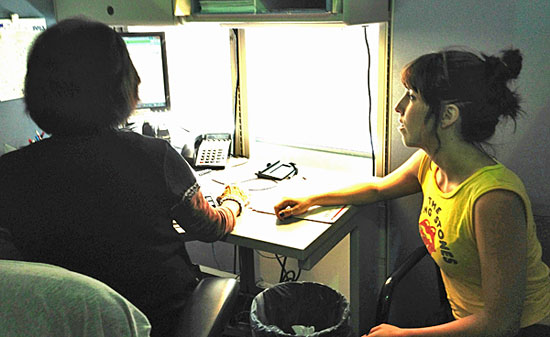
Patient Beth Goodfellow likes the Affordable Care Act, but for now, she’s relying on Healthy Way L.A.
As Californians rushed to sign up for coverage under the Affordable Care Act last week, Beth Goodfellow sat on the sidelines, too sick to join in.
A 28-year-old rock musician newly arrived in Atwater Village from San Francisco, she had planned to wait until her gigs picked up and then shop on the new state exchange for health insurance. But when a pain in her side wouldn’t go away, she found herself at the county’s Mid-Valley Comprehensive Health Care Center, unable to wait until 2014, when the Affordable Care Act kicks in in earnest.
The county’s Rx?
A primary care doctor at the Van Nuys center, and enrollment—right now—in Healthy Way L.A.
As the next phase of healthcare reform approaches a January deadline, Los Angeles County has been busily bridging the gap with its own interim program to channel the uninsured toward coverage.
Come 2014, all Americans will be required to have some form of health insurance, whether via an employer, a private purchase or the government—Medicare or Medicaid, for example.
To ease the shift, that mandate will come not only with subsidized state exchanges like the ones that opened last week to make it easier and cheaper to buy private insurance, but also with a massive expansion of the federal government’s Medicaid program for low-income patients, (or Medi-Cal, as it is known in this state).
While computer glitches with the exchanges have drawn widespread attention nationwide in the past week, Los Angeles County has continued to power ahead with a related effort: enrolling as many eligible uninsured patients as possible in a local program called Healthy Way L.A.
Created in 2007, Healthy Way L.A. isn’t technically health insurance and, except for emergency services, doesn’t cover members outside Los Angeles County. But it does offer free, publicly funded health care to the kinds of patients who mostly end up being treated by the county and community clinics—those who can’t afford private insurance, or whose jobs don’t include it.
The program covers legal residents aged 19 to 64 who earn too much to qualify for Medi-Cal right now and still make less than 133% of the federal poverty level (less than about $1,274 monthly for one person). Because all of those patients will become eligible for government-subsidized insurance under the terms of next year’s expansion, health officials are viewing Healthy Way L.A. as a quick and easy steppingstone to the new, more broad-based version of Medi-Cal.
Thousands of uninsured patients have been registered for Healthy Way L.A. at health fairs, county hospitals and health care centers and community clinics, and, as January approaches, the county has moved aggressively.
Dr. Mitchell Katz, director of the county’s Department of Health Services, told the Board of Supervisors on Tuesday that the county is well on its way toward reaching its goal of 300,000 sign-ups for the program.
Sheryl Spiller, head of the county’s Department of Public Social Services, which is playing a central role in registering people for the program, told supervisors that 275,000 already have been signed up.
“Things are moving along and we’re ready,” Spiller said.
The stakes are high, both for patients and the county.
Giving patients a fast track to insurance gets them accustomed to regular checkups at a regular location. That, in turn, helps keep them healthier and holds down healthcare costs by preventing expensive emergency room visits.
But another reason for the push is that the county wants these patients. When the Healthy Way L.A. clients transition to Medi-Cal, the federal government will begin picking up all or most of the cost of their healthcare—a tab that the county is helping to pick up currently.
Moreover, even with the Affordable Care Act, the county will remain the provider of last resort for some 400,000 undocumented residents and others who will remain ineligible for any insurance. The county will need as many covered patients as possible to stay financially afloat
So with only a couple months until January, the county is pulling out all the stops to get future Medi-Cal recipients into the pipeline.
“It’s crunch time,” said Deedra Williams, public information officer for ambulatory care at the Department of Health Services. “It’s all hands on deck right now.”
Goodfellow, the rock musician, was one of 38 new clients signed up on a single morning last week at the healthcare center in Van Nuys.
And there as elsewhere, officials say the county has been working on its bedside manner, because under Medi-Cal, the Healthy Way L.A. clients who now get their care from county doctors and community partners will be able to shop around for healthcare.
“We’ve been serving this population for two years now, but we’re focusing on making sure that we provide quality care and good customer service,” said Tangerine Brigham, DHS deputy director of managed care services.
DHS officials say the department has been working with Spanish-language television stations to get the word out, and last week, DHS rolled out a new, much more user-friendly web site. And at Mid-Valley, Associate Administrator Linda Kim-Fung said staffers last year underwent intensive customer service training.
“We’re trying to educate our staff to go out of their way to be friendly,” Kim-Fung said. “You know—the customer comes first, be friendly, ask if there’s anything else.”
That’s a good thing, said 52-year-old Ben Ahmadi, an uninsured grocery clerk with diabetes who was renewing his Healthy Way L.A. enrollment.
“There’s nothing wrong with the doctors here,” he said. But, he added, the county system will have its work cut out for it if it wants to compete with established managed health care juggernauts such as Kaiser Permanente, where he once had insurance.
“When I used to have Kaiser, you’d go in and make an appointment and you’d be in there in around 15 minutes,” he said.
Goodfellow said she’s grateful that Healthy Way L.A. was there to cover her in the short term. In San Francisco, she said, she used a similar county health access program and was pleasantly surprised at the quality of care.
“I’m pretty young, so I just tend to go to the doctor when I don’t feel well,” she said. “But I think Obamacare is a really good idea and I’m happy we’re coming closer to having health care for everyone.”
Posted 10/8/13
Grand Park comes of age
October 3, 2013
They built it. And they came.
This week marks the one-year anniversary of downtown’s Grand Park, a four-block expanse that has provided a jolt to Los Angeles’ Civic Center for reasons well beyond its hot-pink furniture.
Since its dedication last October, the 12-acre park between the Music Center and City Hall has drawn tens of thousands visitors for events big and small, from a Fourth of July extravaganza to daily yoga classes. Although the big-city development around it continues to be vigorously debated, the park itself has proven to be an intimately scaled magnet for families and children. The “splash pad” at the Arthur J. Will Memorial Fountain, in particular, has drawn knee-high youngsters and their parents from across the region.
“It’s just as serene and beautiful as I expected,” said Kesha Barkulis, who, on a recent and sparkling autumn weekday, was following her drenched and teetering 9-month-old daughter, Luna, as she navigated the 79 gentle water jets of the fountain.
It was their first visit to Grand Park, one that Barkulis said she’d wanted to make all summer, ever since reading about the ¼-inch-deep pool on a website aimed at moms seeking kid-friendly outings. They had taken the Red Line subway from North Hollywood to the Civic Center station, located just steps away from the fountain, which has become a popular venue for toddler birthday parties now.
For decades, the area formerly known as the “Civic Center Mall” was largely hidden by concrete parking ramps and two blockish government buildings—the Superior Court and Los Angeles County Hall of Administration. As a result, the mall and its 1960s-era fountain ended up being used mostly as an outdoor break area for bureaucrats and jurors.
But after a $56-million privately-financed makeover, which was required as part of the approval process for commercial development along Grand Avenue, the park is now generating crowds—and buzz—through a mix of programming experiments overseen by the Music Center.
The Fourth of July event, for example, drew an estimated 10,000 people, according to Grand Park Programming Director Julia Diamond. Thousands of people, she said, also have shown up for dance events and a movie series featuring such family fare as “ET” and “The Never Ending Story.” Last Sunday, 2,000 music fans gathered on a Grand Park lawn to watch the first simulcast of a Walt Disney Concert Hall performance, which featured jazz great Herbie Hancock.
Not bad for Year One.
“People think of Angelenos as wanting to celebrate privately,” Diamond said. “But people in L.A. are game for sharing.”
The park, which she called a “cultural and civic space with no walls,” has tapped into that growing hunger for collective experiences, exemplified by the widely popular CicLAvia events.
One key to the park’s early success, Diamond said, is that thousands of people in offices and lofts downtown “have actually shown a large appetite for diversion and entertainment in the middle of the day, uniting around something that speaks to a part of themselves outside of their work lives.” Besides lunchtime yoga and informational fairs on such topics as green transportation and public health, the mid-day programming has included a weekly farmer’s market and concerts ranging from Latin jazz to classical music to pop.
Diamond said she’s also been struck by the ethnic and economic diversity of the visitors—a result, she suggested, of having a park without a strong neighborhood history or existing identity. “This gives the park a lot of freedom to be whatever people want it to be,” she said.
Still, not everything’s gone as the programmers had hoped. One of the biggest first-year challenges, Diamond said, has been to get the downtown workers to become an after-hours crowd. “They get into their cars and drive away,” she said, adding: “If you gave people a reason to stay, they would. We haven’t found that reason yet.” (One possible reason: Grand Park’s official 1st birthday bash, which takes place from 7 p.m.-10 p.m. on Thursday, Oct. 10, and features free entertainment on the Performance Lawn.)
Diamond said Grand Park programmers and marketers also have been stymied by the nature of downtown itself, which she described as “sort of like the Balkans.” The farther away from Grand Park people work, such as in the Bunker Hill area, the harder they are to engage. Downtowners, she said, “tend to stay in their micro-community.”
Diamond’s anniversary wish for the next year?
“I want everyone in Los Angeles to know about Grand Park,” she declared. “A year ago, we didn’t exist. I want that name to have instant recognition as an amazing place.”
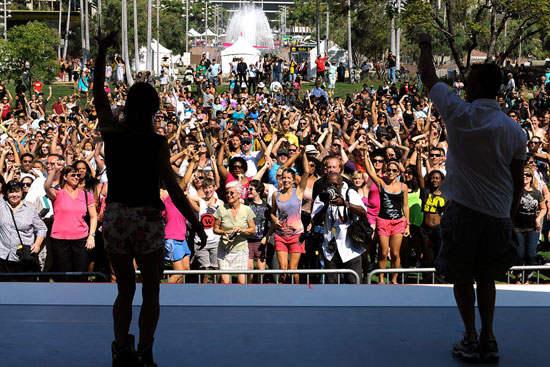
Grand Park's music events have proven particularly successful in drawing crowds during the first year.
Posted 10/3/13
LACMA redesign to respect tar pits
September 26, 2013
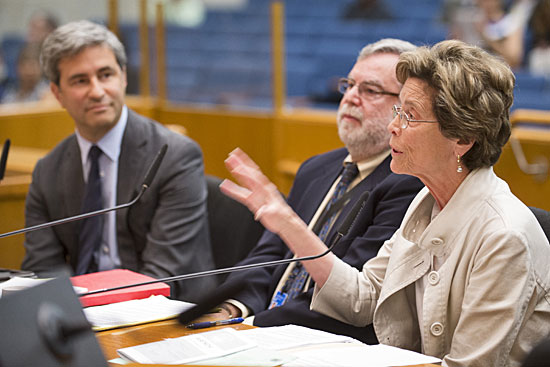
Jane Pisano of the Natural History Museum addresses supervisors, as LACMA's Michael Govan, far left, and James Gilson of NHM look on.
Leaders of the Los Angeles County Museum of Art and Natural History Museum are pledging to work together to make sure that a proposed new signature building on the LACMA campus doesn’t harm the landmark La Brea Tar Pits.
Preliminary plans for the new art gallery, to be designed by Pritzker Prize-winning architect Peter Zumthor, were unveiled this summer as part of LACMA’s “Presence of Past” exhibition, which showcased the architect’s concepts for transforming the museum campus.
The Swiss architect’s proposal calls for a largely transparent gallery—allowing passersby to view art through glass even without entering the museum—built in a curving shape reminiscent of the tar pits on the site.
But concerns about those tar pits quickly bubbled up after an early model and design were put on public display.
Officials of the Natural History Museum and its Page Museum, which oversees the Pleistocene era fossil-rich tar pits as an active scientific research site as well as a public attraction, were worried about the impact of the proposed LACMA construction.
On Tuesday, leaders of LACMA and the Natural History Museum came together to inform the Board of Supervisors that they are committed to working together to make sure the tar pits are protected.
“We can guarantee that there will not be a significant impact on the La Brea Tar Pits as we develop the plan,” Michael Govan, LACMA’s director and CEO, told the supervisors. He added that the design, now in its “earliest stages,” is meant not only to improve LACMA but also to create better access to the Page Museum and the tar pits that share the Hancock Park site, which he said would end up with an additional 1.2 acres of ground space. A cantilevered section of the design over the tar pit lake bed already is being altered in response to concerns, Govan said.
Jane Pisano, the Natural History Museum’s president and director, noted that LACMA’s plan is still “very preliminary and fluid, and if there is a negative impact on the tar pits, the design can and will be adjusted to protect them. This is something that Michael has said many times, and we take him at his word.”
However, she added, there are challenges ahead.
“Preliminary review of the plans for the building indicate that it would severely impact six of the nine tar pits in the park,” she said.
“So, early days, we know we have a lot of work to do. But we are assured that it is early days,” Pisano said. She said the early collaboration is essential to ensure that this “world-renowned destination” and unique scientific resource isn’t harmed.
“Ice Age fossils and micro fauna trapped in the tar below the surface provide invaluable information about life thousands of years ago, as well as possible clues for climate change and habitat in the future,” Pisano said.
Both parties said they are continuing to work with the county’s Chief Executive Office in the coming weeks to develop a memorandum of understanding to help them chart the course ahead. If the project is approved by LACMA’s board of trustees, the museum would undertake a two-year feasibility study. Construction would not begin until sometime after a new motion picture museum opens on the campus in 2017.
Govan said that the project presents LACMA with a unique opportunity to be a leader in reimagining how an encyclopedic museum can be structured.
“It has a plan that will be more accessible to the public than I think any that’s been designed anywhere in the world to date,” he said. “And that’s one of the exciting opportunities of a museum in a park.”
Doing nothing is not an option, he added, given the deteriorating state of the four buildings that would be replaced by the new structure.
Just bringing those buildings up to code would cost $317 million, he said. Early construction cost estimates for the new building range from $400 million to $450 million—costs that would be offset by significant energy savings from the building’s solar panels and by an increase in visitors to the museum, he said.
Supervisor Zev Yaroslavsky said that he was “not overly thrilled’ by the design at first, but has come to see it as a “stroke of genius.”
“This is a controversial plan architecturally. Any decent architectural plan is going to be controversial. If there’s no controversy, it isn’t worth the paper it’s written on.”
“Being able to build your project without doing any damage to the tar pits and the scientific research that continues to be done there is a no-brainer,” Yaroslavsky said. “There is room enough on that campus for both the tar pits and for the museum. And that’s the way it’s going to have to be.”
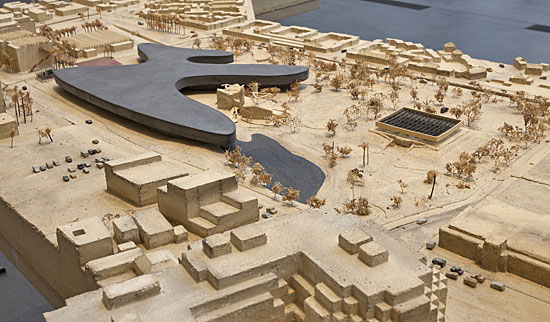
Architect Peter Zumthor's initial vision for LACMA shows a cantilever over tar pit lake bed. That element has since been altered. Photo/LACMA
Posted 9/25/13
Veterans come in on a high note
September 26, 2013
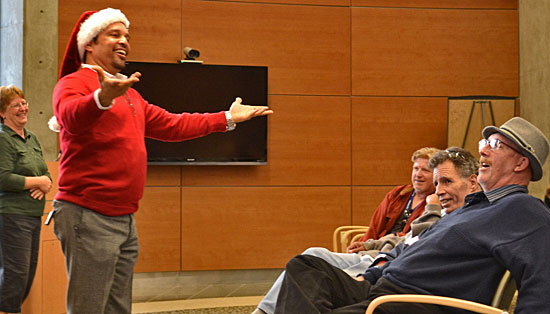
Performance tickets and holiday recitals are just part of the program as LA Opera reaches out to vets.
When “Carmen” struts her stuff on the Dorothy Chandler Pavilion stage at this Sunday’s matinee, there’ll be all the passion, lyricism and high drama you’d expect from Bizet’s operatic masterwork.
And, sitting in some of the best seats in the house, there’ll be a group of audience members you wouldn’t necessarily expect to find soaking up all that tempestuous romanticism: U.S. military veterans, growing into opera buffs thanks to an LA Opera program now entering its second year.
The veterans’ program is part of LA Opera’s Community Circle outreach, which makes thousands of tickets available each season to non-profit and community groups. Some pay a sharply discounted rate of $9 apiece for the tickets, which ordinarily go for about $105, while others, like veterans, get in free.
As a result, veterans from residences for retired military personnel in West L.A. and Long Beach have been getting a taste of the art form that some had known only from the movies—if at all.
“Last year, they saw four operas—Madame Butterfly, Tosca, The Flying Dutchman and Cinderella—and many of the vets were first-time opera-goers,” said Stacy Brightman, LA Opera’s director of education and community programs.
Millie Taylor, 89, who served as a Navy nurse during World War II and now lives at the Veterans Home of California in West Los Angeles, is relishing the prospect of seeing “Carmen,” conducted by Placido Domingo, no less.
“I love the music and the dancing and all the fiery action,” she said. “The costumes are just out of this world. I’m really looking forward to it.”
Taylor, who had never been to the opera before last year, reveled in the personal attention and great seats her group received—“just like paying customers.”
While some of the 16 West L.A. Veterans Home residents heading to the opera Sunday will be neophytes, Sadie Sonnenreich is not among them. The 99-year-old Army veteran says she’s been enjoying opera for half her life.
“It’s the music itself. I love the opera songs,” she said.
The opera’s outreach to vets isn’t limited to the performance tickets; speakers also present pre-opera talks at the residences to explain plot nuances and introduce some of the vocal talents they’ll be hearing. Opera artists also have performed holiday recitals for the veterans.
“People ask, why veterans? Well, who better than veterans?” LA Opera’s Brightman said. “We try to have each group come no more than once a year, but the veterans are the one we break our rule for. Their service to us all is so astonishing. It’s an honor to do anything we can for them.”
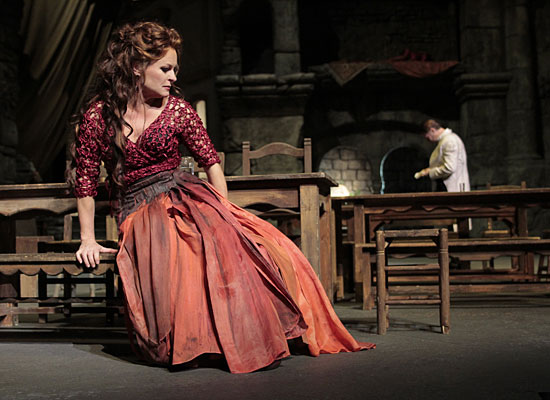
Veterans will see Patricia Bardon performing the title role in "Carmen" Robert Millard photo/LA Opera
Posted 9/26/13
Gate latching hits a roadblock
September 26, 2013
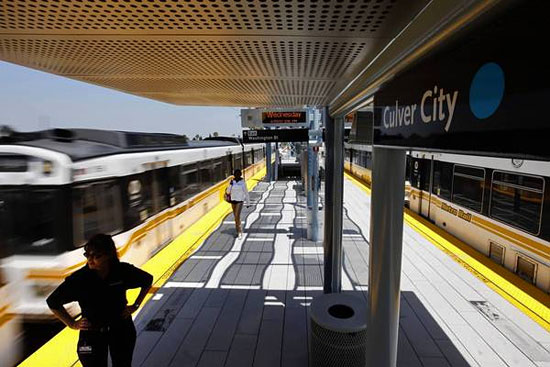
Elevated light rail stations, like in Culver City, are among the next targets for latching. Photo/L.A. Times
L.A.’s subway system has locked its gates and finally moved past an honor system that’s been in place for more than two decades. But it’s a different story at dozens of Metro light rail stations, which usually have stand-alone fare-card readers but no barriers to entry.
David Sutton, Metro’s deputy executive officer in charge of the gate-latching project, said that won’t change any time soon. Last week, in response to a July motion from several members of the Board of Directors, Sutton and his team released a report on the feasibility of installing lockable turnstiles on Phase 1 of Expo Line and at future stations throughout the expanding rail system.
“We’re not going to be able to lock them all,” Sutton said. “Some of the stations just don’t lend themselves to gates because of the space available and the cost.”
The primary reason is safety, said Rick Meade, who manages station construction for the agency. The National Fire Protection Association requires safe evacuation of platforms within 4 minutes in case of an emergency, as well as clearance to a “safe distance” within 6 minutes.
“As soon as you put gates on there, your exiting calculations are going to change because you have an obstruction that slows everything else down,” Meade said. Underground and aerial stations have space to accommodate enough gates for a swift exit, he said, but street-level stations usually do not. For those, increasing the size of platforms is often the only solution, a costly proposition that can encroach on traffic lanes or other property.
Some stations on the light rail system are already equipped with turnstiles, and their latching is slated for completion by February, Sutton said. On the Gold Line, the 5 out of 21 stations with turnstiles were latched earlier this month. Next up is the Blue Line, where 6 of 21 stations are scheduled to be latched in December, followed by all 14 stations of the elevated Green Line.
Along all Metro’s light rail routes, there currently are 41 stations where customers can enter without a barrier requiring payment, including the entire first phase of Expo Line. Sutton and his team examined the possibility of installing barriers at all non-gated light rail stations and have identified 13 for further analysis.
For Expo’s first phase, Metro estimates it would cost $3.1 million to add gates to three elevated stations, an investment the agency says could be recouped within 7 years because of increased fare collection. At the street-level stations, where there’s no room for gates, Metro is planning to add more stand-alone card validators at a cost of $173,000, plus $141,000 in annual operating expenses. Sutton said the non-gated card readers have been effective elsewhere in the system in reminding riders who want to comply with the rules to tap their fare cards.
“With gates and these kinds of things, it keeps honest people honest,” Sutton said.
Sutton said he plans to return to Metro’s Board of Directors in January with a full engineering analysis of what would be needed to install gates and additional card validators on Expo’s first phase, which goes from downtown to Culver City.
A similar gating scenario is being faced by Expo’s second phase, which will end in Santa Monica and is now under construction. At least two of the seven stations in that phase could not have locked gates, while four others are able to accommodate barriers and one other is being reviewed. For future rail projects that have yet to be designed or constructed, lockable gates will be required, Sutton said.
Meanwhile, on the Red and Purple lines, where gates have already been latched, preliminary data on fare collection for August is encouraging, showing a 22% increase in ticket machine sales over the same month last year—worth more than $614,000. Sutton said many free riders have left the system, opening more seats for paying customers.
The latched stations have also been a help to law enforcement, said Lieutenant Sergio Aloma, a transit services officer with the Los Angeles Sheriff’s Department, which is tasked with policing the system.
“Any time you can latch stations, it is better from a fare enforcement standpoint,” Aloma said. “I just wish we could latch them all.”
Aloma said latching even some gates allows officers to be deployed in larger numbers to non-gated locations. The increased visibility of law enforcement, he said, works as a deterrent to would-be fare evaders.
Aloma also said that, even at stations where gates are locked, dedicated scofflaws will find ways to beat the system by, for example, sneaking through access points for disabled people or jumping turnstiles. On the other hand, some riders may make honest mistakes such as forgetting to tap their fare cards when transferring lines as they try to figure out the new system.
“In some cases deputies have to use discretion and determine whether we need to take a customer-relations viewpoint or an enforcement viewpoint,” Aloma said. “This is still new and we want to educate folks on how to use the system.”
Posted 9/26/13
New law puts bike czar in rider’s seat
September 26, 2013
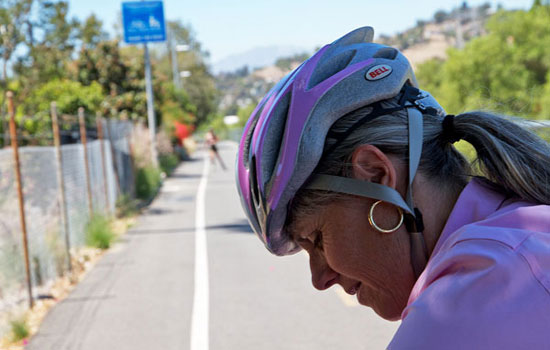
Senior bike coordinator Michelle Mowery has seen a sea change in attitudes about biking in Los Angeles.
You’ve got to hand it to Michelle Mowery. For two decades, she’s persevered, holding the job of “bicycle coordinator” in the nation’s most car crazy city. “A candle in the wind,” she calls herself. Make that a hard-blowing headwind.
But now, almost overnight, Mowery’s mandate has found a powerful constituency in City Hall and on the roads, giving her once-invisible position in the Los Angeles City Department of Transportation rising stature.
“We’ve put in more bike lanes in the past two years than during my entire career here,” she says. “We have a lot of work to do, but we’re getting stuff done.”
The latest achievement came this week, when Gov. Jerry Brown signed a law requiring California motorists to stay at least 3 feet away from cyclists when passing—a requirement already in effect in 22 other states. Four earlier versions of the measure had died because of various safety and liability concerns.
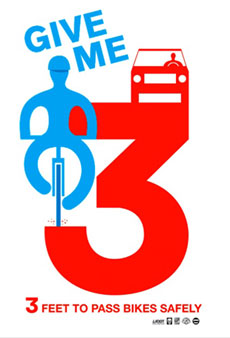 When Mowery heard the news on Monday, she says one word came to mind: “Finally.” For years, she had championed such a law, alongside elected officials in Los Angeles and bicycle advocates statewide. She praises the measure as “a start and an acknowledgement that cyclists need that little bit of space to stay safe.” It will take effect next September.
When Mowery heard the news on Monday, she says one word came to mind: “Finally.” For years, she had championed such a law, alongside elected officials in Los Angeles and bicycle advocates statewide. She praises the measure as “a start and an acknowledgement that cyclists need that little bit of space to stay safe.” It will take effect next September.
According to the California Bicycle Coalition, which launched a “Give Me 3” campaign with Los Angeles advocates to give visibility to the issue, passing-from-behind collisions are the state’s leading cause of bicyclist fatalities. In fact, Mowery says, a galvanizing moment in the long effort to win passage of a buffer zone for cyclists came in 2006, after popular UC Santa Barbara triathlete Kendra Payne was struck and killed by an asphalt truck that tried to pass her on a sharply-curving road.
Mowery says existing California law simply states that drivers must keep a “safe distance” when passing cyclists, a subjective standard. Now, she says, law enforcement has been given a specific tool to cite motorists who invade a rider’s legal space. Even if police don’t make enforcement a top priority, the legislation’s educational value alone could save lives, says Mowery, a lifelong cyclist who’s now 54. She added that this is especially true in Los Angeles, where riders often need more room to dodge bad pavement conditions. “They’re not always able to ride in a straight line,” she says.
Mowery attributes the growing clout of cyclists to shifting demographics. She says that when baby-boomers like her learned to drive, the region’s freeways were new “and wide open. It was the land of opportunity for cars.” These days, however, the under-30-crowd is driving less, while increasing numbers of teenagers are deciding not to even get drivers licenses.
“They see people sitting in traffic and it doesn’t look like fun,” Mowery says.
Eric Bruins, planning and policy director of the Los Angeles County Bicycle Coalition, agrees, calling this “a golden era for bikes.” The new buffer-zone law, he says, is a “huge” step forward. “For us on the street, this is something we encounter every single day. Everybody just needs a better understanding of what it means to pass safely, and that’s what this law provides.”
Bruins credits Mowery with being a leading force behind the new law through her advocacy in Los Angeles and as a member of statewide cycling organizations. “I don’t think the bike community has understood what a quiet champion she has been…She’s been trying to get this [law] passed forever.”
Bruins says that, for years, Mowery had been a controversial figure, the public face of City Hall recalcitrance to demands for more bike friendly streets. But now, with the growing influence of Los Angeles cyclists, Bruins says, the city’s bike boss is riding high.
Says Bruins: “She is finally empowered to do her job.”
Posted 9/26/13
Betting on a shore thing
September 19, 2013
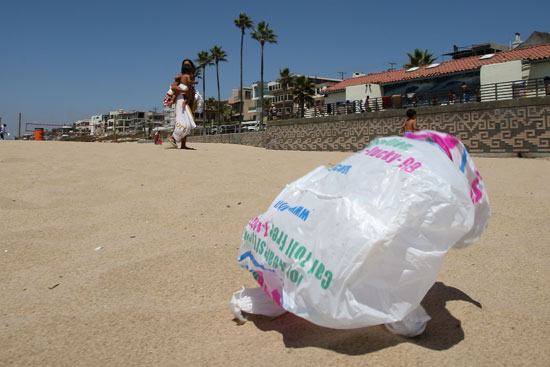
With plastic bag bans taking hold across the state, officials say our beaches are becoming beneficiaries.
At the end of each summer, the beach gets a close-up.
On the annual Coastal Cleanup Day, which occurs again on Saturday, thousands head to beaches and watersheds to pitch in during what’s billed as the largest volunteer event in the world. The junk they collect provides a troubling snapshot of how some of our bad habits can affect the environment.
During last year’s cleanup, a whopping 516,798 pounds of debris was collected statewide. The biggest offender was cigarette butts, accounting for 217,423 pounds, or 42 percent of the total. But plenty of other stuff was collected, too, including 94,182 pounds of food wrappers and containers, 43,783 pounds of plastic bags, 1,159 pounds of condoms, 1,187 pounds of six-pack holders and 508 pounds of syringes. You get the idea.
In L.A. County alone, 43,427 total pounds of debris was picked up last year, despite a volunteer turnout that was significantly reduced by triple-digit temperatures.
Still, the numbers offer a ray of hope. Eben Schwartz, who organizes the statewide volunteer push for the California Coastal Commission, said plastic bags, which take hundreds of years to decompose, are declining in jurisdictions that have enacted restrictions.
“In San Francisco, bags are way down the past couple of years,” Schwartz said.
Bans on single-use plastic bags started in the Bay Area around 2007 and are now banned throughout Alameda County. L.A. County banned plastic bags in 2010, but the ordinance only applied to county facilities and unincorporated areas, representing a small slice of the region’s total population. Other jurisdictions have since followed suit. In June, the City of Los Angeles got on board with an ordinance that will take effect next summer.
“On future cleanup days,” Schwartz predicted, “there’s going to be a whole lot less plastic bags in Los Angeles.”
Officials say that other government measures appear to be having an impact, too, including bans on Styrofoam containers and the installation of storm-drain screens to catch debris. The amount of trash collected statewide during Coastal Cleanup Day 2012 was just 12 pounds per person, down from 19 pounds in 2011, 15 pounds in 2010 and 17 pounds in 2009.
Over the past decade, catch basin screens have been installed in storm drains throughout L.A. County, said Kerjon Lee, spokesperson for the county’s Department of Public Works. The basins block trash from entering inland waterways and reaching the ocean.
Further downstream, Lee said, trash booms are deployed after rain storms to catch debris that has made it down flood channels and rivers. “They are good systems but they are end of the pipe systems,” Lee said of the booms. “It’s kind of a last, valiant effort to prevent debris from entering water bodies.”
Meanwhile, public health initiatives, such as banning smoking on the beach, have also had a positive impact on the on the environment, reducing trash on the sand and in the water, Lee said.
But not everything can be caught before it hits the water, and that’s where Coastal Cleanup Day comes in. The event began in Oregon in 1984. Nine years later, it had entered the Guinness Book of World Records as the “largest garbage collection.” The event has now spread to 35 states and nearly 100 countries. Here in L.A. County, both inland and at the coast, 11,000 volunteers will fan out on foot, on kayaks and even in wetsuits and scuba gear.
Liz Crosson, executive director of Los Angeles Waterkeeper, organizes a yearly scuba cleanup around “Hyperion Pipe,” which sends L.A.’s treated waste water miles out to sea. The structure that holds the pipe in place catches a lot of trash that enters the ocean. “I am amazed at what they pull out of there,” Crosson said. “They get pounds and pounds of plastic bags.”
Heal the Bay has been the lead organization for L.A. County’s Coastal Cleanup Day since 1990. Marissa Maggio is coordinating the event for the nonprofit environmental group.
“You can notice a difference; there’s definitely less debris at certain beaches,” said Maggio, who hopes to inspire people year round. “It would be great if every time you went to the beach, you bring a bucket and glove and pick up a little trash.”
Posted 9/19/13
A time to stay the course
September 19, 2013
After many years in office, I know how tempting it is for political bodies to jump into action when a problem is generating headlines or otherwise commanding public attention. But sometimes what sounds like a good idea may actually be counterproductive, falsely raising expectations at the precise moment when careful and dispassionate analysis should rule the day.
Such an issue surfaced this week at the Board of Supervisors, where my colleagues Mark Ridley-Thomas and Gloria Molina introduced a motion calling for the permanent creation of a Sheriff’s Department Oversight Commission, whose members would be appointed by the board.
They argued that ongoing investigations by the U.S. Justice Department and continuing allegations of brutality by deputies in the jails proved that a new level of civilian oversight was needed—one that a busy Board of Supervisors alone cannot provide. A vote is scheduled for October 8.
I certainly share the proponents’ desire to tighten the reins on the Sheriff’s Department, but let me tell you why I’ll be among the “no” votes.
As many of you may know, I’ve spent a good deal of my public life holding our region’s two biggest law enforcement agencies accountable for unconstitutional behavior, from the political spying and excessive force of the Los Angeles Police Department back in the 1980s to the escalating brutality inflicted on L.A. County jail inmates by sheriff’s deputies in more recent times. In fact, I championed the establishment of the Citizens Commission on Jail Violence, whose esteemed members last year proposed more than 60 reforms for the Sheriff’s Department’s jail operation.
The lynchpin of those widely-praised recommendations was the creation of an Office of Inspector General to provide rigorous, independent oversight of the department, reporting directly to the Board of Supervisors. We will soon review candidates to lead this essential watchdog agency.
The blue-ribbon panel—whose members included former federal judges, a big-city police chief and a prominent south Los Angeles pastor—specifically considered whether to recommend the creation of a permanent civilian commission, like the one now being proposed. The answer: no.
“The Commission believes that a fully empowered and integrated Office of Inspector General reporting to an engaged Board of Supervisors can provide the necessary independent oversight of the Department to ensure that it implements meaningful and lasting reforms,” the panelists wrote in their final report. The creation of another civilian commission, they said, “was not necessary.”
And should anyone question the Board of Supervisors’ level of engagement, Tuesday’s meeting alone should have offered an answer. Besides the proposal for a new oversight body, our day was packed with reports and debate on the status of the earlier jail commission’s recommendations, the decreasing number of serious use-of-force cases, and methods of coping with thousands of new inmates now serving sentences in the county lockup rather state prison because of sweeping changes to California law.
The strongest argument against a new oversight commission is simply that it would be powerless to force changes within the Sheriff’s Department. And, despite the suggestions of the measure’s backers, the Los Angeles Police Department does not provide us with a model for civilian governance.
The sheriff is publicly elected, making him directly accountable to voters every four years. Although the Board of Supervisors holds the purse strings, state law expressly gives the sheriff here and in counties across the state wide control over the operations of their departments. The LAPD chief, on the other hand, is politically-appointed and, under the city charter, reports directly to a five-member Board of Police Commissioners, which governs the department.
In their final report, the jail commission pointedly noted the difference between the two law enforcement agencies, saying that “a civilian jail commission would not have any legal authority over the Sheriff’s Department absent enabling [state] legislation.” The probability of getting such legislation is, at best, remote. In other words, the proposed commission would amount to little more than a soapbox for the panelists—and a disappointment for those of us committed to a top-to-bottom cultural change.
On Tuesday, my colleague, Don Knabe, called the proposal for a new commission “a bit premature.” I agree. The Citizens Commission on Jail Violence, staffed by some of L.A.’s brightest criminal justice minds, offered us a detailed roadmap to reform. That includes allowing an inspector general—whose authority Sheriff Lee Baca has said he will accept—to hold the department accountable through meaningful oversight.
We shouldn’t now be looking for shortcuts that, in the end, would divert us from our destination.
Posted 9/19/13
Love on the beach
September 18, 2013
From cigarette butts to lottery tickets, you never know what you’ll find at the International Coastal Cleanup. Eveline Bravo and Olga Ayala, for instance, found love.
It was 2007, and Bravo, brand new in her job as Heal the Bay’s beach programs manager, was recruiting site captains for the worldwide volunteer day, which this year takes place on Saturday.
Ayala was enlisted to help with the effort—the second year in a row that she had been called upon to round up volunteer trash-pickers.
At first, neither was particularly enamored of the other.
“The year before, and I kid you not, they had called me just one weekend prior,” Ayala remembers. “And I had dropped everything and done everything in my power to help them, but only about 15 people showed up.
“So this time, I was thinking ‘Maps, geographic zones, resources, highlighters—I’m gonna show them how you do this.’ And she was, like, ‘Uh, that sounds great, but actually, here’s how we’re going to do it.’ ”
“We clashed,” Bravo says, laughing. “I wanted to do my job my way.”
For months after that first meeting, their relationship remained frosty, even though Ayala—secretly impressed by the competence of the 10-years-younger Bravo—mustered hundreds of volunteers and broke a Heal the Bay record that year with the tonnage of trash they retrieved from their assigned cleanup site, a Panorama City park. (Cleanups in inland areas are a large part of the beach initiative because everything that gets into local waterways ends up in the ocean.)
With time, however, the ice melted. “She became like a challenge to me,” says Ayala. “I was like, ‘I’m nice, and you’re gonna like me.’ ” Bravo, meanwhile, says she began to do some soul searching.
“My New Year’s resolution that year had been to be nicer to people, and for some reason, as I made it, my thoughts went to her. So I sent her an email and a few months after that, we went out dancing. And somebody at the club asked me, ‘Are you two together?’ And after I said yes, I realized that she hadn’t been asking if we had come there together.
“So I looked at Olga and said, ‘I think we just told that girl that we’re together together. And she said, ‘Do you want to be?’ ”
The two became a couple, bound in part by the gifts that had drawn them to public service.
“I admire hardworking people who know what they’re doing,” says Ayala, who at the time she met Bravo was a field deputy to then-Los Angeles City Councilman Tony Cardenas. “And she was so hardworking, and straightforward, and kind, and beautiful—I fell in love.”
For Bravo, Ayala’s open heart was a revelation.
“As we became friends, I realized how pure and genuine she is—nothing bad ever comes out of her brain. I thought that people like that didn’t exist, but somebody can be mean or poor-spirited or a bad influence, and Olga just won’t see it. She never judges. Her heart is just genuinely into doing the right thing.”
In 2010, the bond deepened: Bravo was diagnosed with cancer and they discovered how much harder an ordeal like that could be for gay and lesbian couples, who lacked the legal protections that straight, married people took for granted. After her treatment, Bravo says, they made a pact to throw all their leftover energy and expertise into the marriage equality movement.
“We had to make all these hard decisions and go through surgery and get legal permission for Olga to be in the hospital with me,” says Bravo. “We decided that we needed our rights.”
So last month, a scant six weeks after the courts officially re-opened the doors for same-sex marriage in California, the two were wed in Calabasas by Ayala’s ex-boss Cardenas, who was elected to Congress, representing the San Fernando Valley’s 29th District, in 2012.
Now they live in mid-city Los Angeles with their cocker spaniel Sparky. And on Saturday, you’ll find them at this year’s Coastal Cleanup, picking up trash—together—at the Santa Monica Pier.
Posted 9/18/13




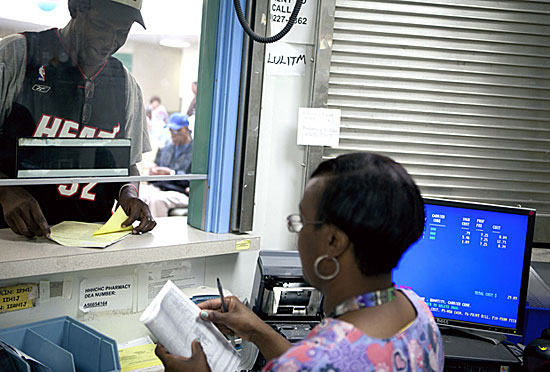


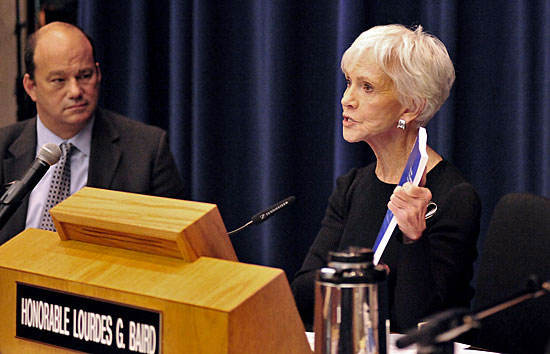
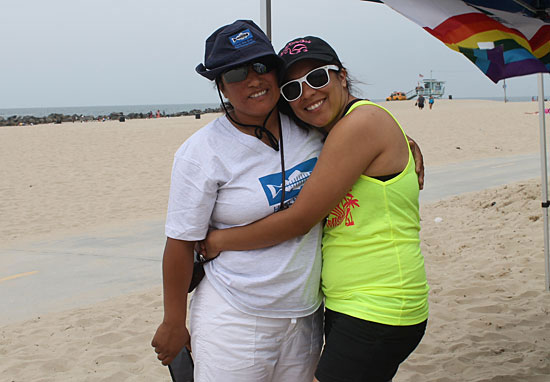
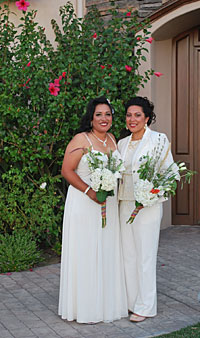





 Check for the latest closure information
Check for the latest closure information








